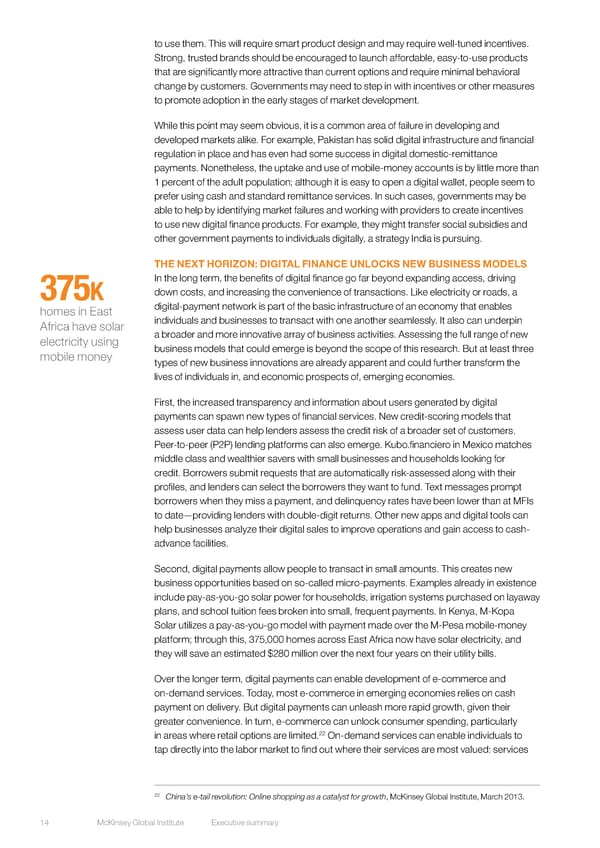to use them. This will require smart product design and may require well-tuned incentives. Strong, trusted brands should be encouraged to launch affordable, easy-to-use products that are significantly more attractive than current options and require minimal behavioral change by customers. Governments may need to step in with incentives or other measures to promote adoption in the early stages of market development. While this point may seem obvious, it is a common area of failure in developing and developed markets alike. For example, Pakistan has solid digital infrastructure and financial regulation in place and has even had some success in digital domestic-remittance payments. Nonetheless, the uptake and use of mobile-money accounts is by little more than 1 percent of the adult population; although it is easy to open a digital wallet, people seem to prefer using cash and standard remittance services. In such cases, governments may be able to help by identifying market failures and working with providers to create incentives to use new digital finance products. For example, they might transfer social subsidies and other government payments to individuals digitally, a strategy India is pursuing. THE NEXT HORIZON: DIGITAL FINANCE UNLOCKS NEW BUSINESS MODELS In the long term, the benefits of digital finance go far beyond expanding access, driving 375K down costs, and increasing the convenience of transactions. Like electricity or roads, a homes in East digital-payment network is part of the basic infrastructure of an economy that enables Africa have solar individuals and businesses to transact with one another seamlessly. It also can underpin electricity using a broader and more innovative array of business activities. Assessing the full range of new mobile money business models that could emerge is beyond the scope of this research. But at least three types of new business innovations are already apparent and could further transform the lives of individuals in, and economic prospects of, emerging economies. First, the increased transparency and information about users generated by digital payments can spawn new types of financial services. New credit-scoring models that assess user data can help lenders assess the credit risk of a broader set of customers. Peer-to-peer (P2P) lending platforms can also emerge. Kubo.financiero in Mexico matches middle class and wealthier savers with small businesses and households looking for credit. Borrowers submit requests that are automatically risk-assessed along with their profiles, and lenders can select the borrowers they want to fund. Text messages prompt borrowers when they miss a payment, and delinquency rates have been lower than at MFIs to date—providing lenders with double-digit returns. Other new apps and digital tools can help businesses analyze their digital sales to improve operations and gain access to cash- advance facilities. Second, digital payments allow people to transact in small amounts. This creates new business opportunities based on so-called micro-payments. Examples already in existence include pay-as-you-go solar power for households, irrigation systems purchased on layaway plans, and school tuition fees broken into small, frequent payments. In Kenya, M-Kopa Solar utilizes a pay-as-you-go model with payment made over the M-Pesa mobile-money platform; through this, 375,000 homes across East Africa now have solar electricity, and they will save an estimated $280 million over the next four years on their utility bills. Over the longer term, digital payments can enable development of e-commerce and on-demand services. Today, most e-commerce in emerging economies relies on cash payment on delivery. But digital payments can unleash more rapid growth, given their greater convenience. In turn, e-commerce can unlock consumer spending, particularly 22 in areas where retail options are limited. On-demand services can enable individuals to tap directly into the labor market to find out where their services are most valued: services 22 China’s e-tail revolution: Online shopping as a catalyst for growth, McKinsey Global Institute, March 2013. 14 McKinsey Global Institute Executive summary
 DIGITAL FINANCE FOR ALL Page 24 Page 26
DIGITAL FINANCE FOR ALL Page 24 Page 26